Harvey Mudd Astronaut Scholars
The Astronaut Scholarship Foundation was created to ensure that the United States would maintain its leadership in science and technology by supporting some of the very best science, technology, engineering and math college students.
The organization awarded its first seven scholarships in 1986. Each founding Mercury 7 astronaut sponsored a $1,000 scholarship, and they then began to fundraise to support future scholarships. Today, the Astronaut Scholarship Foundation awards fifty scholarships valued up to $10,000 to each selected scholar. The Astronaut Scholarship is the largest, merit-based monetary award given in the nation to science and engineering undergraduate students. Harvey Mudd College is one of 27 institutions—and the only non-doctorate granting school—selected by the foundation to participate in the program.
The first Harvey Mudd recipient of the Astronaut Scholarship was Ken Easton ’89, who received the award in both 1987 and 1988. Here are the College’s Astronaut Scholars, beginning with the most recent. Information was compiled from interviews, news stories and Harvey Mudd College Magazine articles.
Alisha Chulani ’25 Awarded in 2024
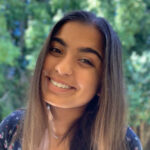
Chulani is an engineering major who has done research in the Lab for Autonomous and Intelligent Robotics (LAIR). During her time with LAIR, Chulani developed a test bed to study robot-fish interactions, which was used in a seafloor mapping project in Costa Rica. She worked as an Office of Housing and Residential Life mentor for two years and is now a proctor for North Dorm. Chulani plays on the Claremont-Mudd-Scripps women’s tennis team and has earned NCAA and Intercollegiate Tennis Association championship titles and 2024 Academic All-American honors. She has won the HMC Female Athlete of the Year award twice. After graduation, Chulani will return to Nvidia where she previously interned, conducting tests on the automation framework of graphic processing units.
Kavi Dey ’26 Awarded in 2024
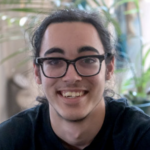
A physics major, Dey worked with Professor Helen Zhou on a brain imaging project in the Multimodal Neuroimaging in Neuropsychiatric Disorders Laboratory at the National University of Singapore. At Harvey Mudd, Dey has worked with visiting professor Gabe Hope on variational deep learning, engineering professor TJ Tsai in the Music Information Retrieval Lab on three-way audio alignment for piano concertos, engineering professor and makerspace Director Matthew Spencer in the Analog Circuit Engineering Lab on ultrasonic beam forming sonar development, and biology professor Matina Donaldson-Matasci in the Bee Lab on zero-shot image classification for pollen species detection. Dey also works in the College’s machine shop as a shop improvement and repair proctor, as a practicum proctor for the Introduction to Engineering Systems course and as a teaching assistant for the Microprocessor-Based Systems: Design and Application course. After graduation, Dey will pursue a doctorate in computer science.
Ryan O’Hara ’24, Awarded in 2023
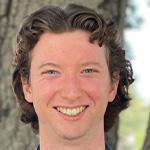
O’Hara is a transfer student double majoring in environmental robotics and computer science/math. He is founder of a direct air capture (DAC) solution that pulls CO2—the primary greenhouse gas driving climate change—from the air and sequesters it away beneath the Earth so it can no longer warm our planet. O’Hara has created a DAC robot that floats on the ocean and uses hydropower and biochar to sequester carbon dioxide. He was inspired to develop his startup during Harvey Mudd’s Entrepreneurship class, led by Kash Gokli, engineering professor and director of entrepreneurship initiatives. O’Hara has since created the startup Apsis Robotics and, in July, he received the 776 Fellowship, a $100,000 grant to help him launch his carbon capture technology.
O’Hara has considerable experience in the climate science community. He worked with Melanie Pickett at NASA’s Kennedy Space Center on the development of an algae-based life support system for the International Space Station, Jeff Schell and the Sea Education Association on a two-month ocean expedition studying the effects of climate change on marine ecosystems, and Sawyer Fuller at University of Washington to build microrobots for use in atmospheric monitoring. This summer, he is working under Swati Saxena at NASA Ames Research Center to build an AI system to monitor contrail emissions.
O’Hara has done climate policy work with the UN and Intergovernmental Panel on Climate Change and is involved in local electoral politics. “I was recently involved in getting a very pro-environmental candidate elected to the Los Angeles city council,” he says.
O’Hara plans to pursue a PhD in earth sciences and engineering. After that, he’ll likely pursue a research career (through entrepreneurship or government work) in climate tech and climate change solutions.
Lucien Tsai ’24, Awarded in 2023
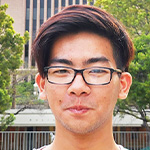
Tsai is inspired by the vision of a world where sustainable materials can replace current energy-intensive materials. With a focus on polymer-based materials, he conducts pure and applied research in materials science to understand the physical principles that govern extraordinary functional and mechanical properties and better inform the design of new materials.
At Harvey Mudd College, Tsai works in the Physics of Soft Matter Lab, advised by Professor Mark Ilton, where he performs novel dynamic mechanical analysis measurements to understand the viscoelastic behavior of soft matter and the various theories developed to model their mechanical properties. He has presented this work at conferences, including the American Physical Society March Meeting and is working to publish a paper about it.
“I am excited about the implications of my work in understanding the energy dynamics of rate-asymmetric, ultrafast biological movements and the applications to emerging fields such as soft robotics and bioengineering in which viscoelastic structures are employed in cyclic mechanical stretching,” says Tsai.
During an internship at Lawrence Livermore National Laboratory, Tsai aided researchers in the synthesis of mesoporous silica particles used in direct air capture. This led him to a deeper understanding of the physical and chemical conditions that influence polymer interactions at the molecular level. This summer, he is working with Mayumi Koichi at the University of Tokyo on strong and resilient hydrogels.
Tsai plans to pursue a PhD in materials science. “Guided by fundamental physical principles and patterns found in nature, I hope to discover the underlying principles for strong yet sustainable materials to replace traditional metals and concrete,” Tsai says.
The ASF is a nonprofit organization established in 1984 by the six surviving members of America’s original Mercury astronauts. The Astronaut Scholarship is the nation’s largest, merit-based monetary award given to science and engineering undergraduate students. Harvey Mudd College is one of 41 institutions—and the only non-doctorate granting school—selected by the foundation to participate in the program.
Amani Maina-Kilaas ’23, Awarded in 2022
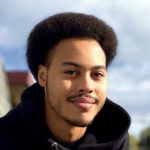
After his first year at HMC, Maina-Kilaas joined the AMISTAD Lab led by HMC computer science professor George Montañez. Lab members investigated how the ability to perceive intention can advantage virtual agents and demonstrated survival benefits in adversarial situations through statistical analysis of various simulations. The work with AMISTAD resulted in three publications—two with Maina-Kilaas as lead author; one as co-lead author—and led to him being nominated for the Goldwater Scholarship and being named one of four Outstanding Undergraduate Researchers by the Computing Research Association in early 2022. He has interned as a software engineer at Stripe and tutored peers in programming languages and introductory computer science. This summer, with University of Southern California computer science professor Muhao Chen, he researched natural language understanding (specifically, machine common sense) in the Language Understanding and Knowledge Acquisition Lab at the Information Sciences Institute. The work of a researcher appeals to him, so Maina-Kilaas will pursue a PhD in computer science. “I would rather spend my career generating new knowledge and advancing the field as a university professor or as an industry researcher,” he says.
Alec Vercruysse ’23, Awarded in 2022
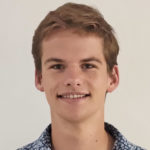
A scholar-athlete, Vercruysse is passionate about electrical and computer engineering. His interest stems from “awe at the power and potential of modern electronics and a desire to harness this power to improve our world,” he says. He has done research with HMC engineering professor Matthew Spencer on phased array technology, which enables advanced transceivers to computationally control the direction of sensitivity of the antennas to improve their gain in relevant directions. “The field of communications and radio-frequency is still in rapid development,” says Vercruysse. “While over half the world is now somehow connected to the internet, reliable access is still a luxury for the lucky half of the world that is connected. Furthermore, as more devices become wireless and wirelessly connected to home and organizational networks, more advanced schemes are required to support this massive increase in devices. Advanced antenna technologies and modulation techniques are in development that can allow wireless communication between an ever-increasing set of nodes without interference or other degradation of quality.” As a member of the Claremont-Mudd-Scripps men’s swimming and diving team that earned the 2020 SCIAC title, he reached the finals in multiple events to help give CMS its victory.
The ASF is a nonprofit organization established in 1984 by the six surviving members of America’s original Mercury astronauts. The Astronaut Scholarship is the nation’s largest, merit-based monetary award given to science and engineering undergraduate students. Harvey Mudd College is one of 41 institutions—and the only non-doctorate granting school—selected by the foundation to participate in the program.
Kaveh Pezeshki ’21(physics), awarded in 2020
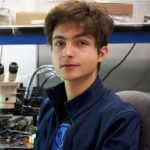
Harvey Mudd College physics major Kaveh Pezeshki ’22 has been named an Astronaut Scholar for the 2021–2022* academic year by the Astronaut Scholarship Foundation (ASF). He is the 27th Harvey Mudd student to receive the honor.
The ASF selects college students pursuing careers in science, engineering and mathematics who exhibit initiative, creativity and excellence in their chosen field and provides opportunities for mentorship and professional development with industry professionals as well as a $10,000 scholarship prize.
Pezeshki is actively involved with research groups on campus and is interested in pursuing a career in physics and engineering. While at Mudd, he has pursued opportunities to work in chip design and electronics, both in academic and personal work.
“I’m most excited for the Astronaut Scholar technical conference,” Pezeshki says. “I’m looking forward to learning about other scholars’ research and to present and receive feedback on my work.”
Typically, as part of the scholarship program, Astronaut Scholars are invited to attend the ASF Innovators Weekend in Washington, D.C. and participate in the Astronaut Scholars Technical Conference, where scholars present their research and meet fellow Astronaut Scholars and industry professionals. However, due to the COVID-19 pandemic, the in-person event has been reformatted to an online platform to allow scholars to virtually meet and present their research to a captive audience. The in-person event has been tentatively rescheduled for late 2020.
During summer 2020, Pezeshki interned at a small optoelectronics startup in the Bay Area, primarily designing high-speed photodetectors for new computing platforms. He hopes to have a paper ready to publish by the end of the summer.
At Harvey Mudd, he is a member of the Department of Engineering’s Clay-Wolkin Fellowship program, advised by David Harris, Harvey S. Mudd Professor of Engineering Designand associate department chair. The program provides students with opportunities to pursue basic and applied research initiatives in very-large-scale integration (VLSI) design. Pezeshki joined the fellowship program as a first-year student and has worked with Harris on digital and chip design.
“I’m incredibly grateful to Professor Harris,” says Pezeshki. “He’s been an amazing research advisor and has pointed me toward so many cool opportunities.”
Pezeshki is also a co-systems administrator of the engineering department’s server. He assisted in designing and building the current server and is responsible for setting up and maintaining software for courses and research groups.
In addition to his research and academic work, Pezeshki and his roommate, Kye Shi ’21(CS and mathematics), design “room improvement projects” in their free time. Recent projects include a double-featured pulley control that allows Pezeshki to adjust room lights from his bed and Slack-controlled LED lights for the room.
After graduation, Pezeshki plans to pursue a PhD in applied physics and engineering and specialize in solid-state devices.
The ASF is a nonprofit organization established in 1984 by the six surviving members of America’s original Mercury astronauts. The Astronaut Scholarship is the nation’s largest, merit-based monetary award given to science and engineering undergraduate students. Harvey Mudd College is one of 41 institutions—and the only non-doctorate granting school—selected by the foundation to participate in the program.
*Pezeshki was able to defer his original 2020–2021 Astronaut Scholar award due to the pandemic.
Emily Shimizu ’20 (biology/chemistry), awarded in 2019
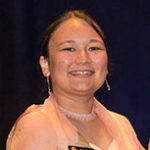
Harvey Mudd College joint chemistry and biology major Emily Shimizu ’20 has been named an Astronaut Scholar for the 2019–2020 academic year by the Astronaut Scholarship Foundation. She is the 26th Harvey Mudd student to receive the honor, which includes a scholarship prize of up to $10,000 and opportunities for professional development and mentoring.
“Besides the scholarship itself, I am particularly excited about the mentoring program,” Shimizu says. “The Astronaut Scholarship Foundation is a very encouraging and supportive community of scholars, who are already helping to advise me this semester as I apply to graduate school to pursue a Ph.D. in chemistry.”
Shimizu says her ASF mentor has given her guidance on graduate schools and has expanded her knowledge of career paths post-graduate school.
While attending the three-day Astronaut Scholarship Foundation Innovators Weekend in August, Shimizu had the opportunity to meet other astronaut scholars and attend the Innovators Gala, which featured Apollo 16 moonwalker Charlie Duke as keynote speaker. Scholars visited the National Institutes of Health in Washington D.C. and attended a National Science Foundation panel on future research funding opportunities, including the Graduate Research Fellowship Program, which Shimizu intends to apply for.
Shimizu was nominated for the Astronaut Scholarship by David Vosburg, professor of chemistry, who has worked with her on numerous projects during her time in his research group at HMC.
Among their research projects, Vosburg has worked with Shimizu on creating a one-step process for the anesthetic lidocaine. The procedure is commonly used in dentistry and will be featured in the Organic II Laboratory course at HMC in the fall. The project is being further developed by collaborators at the University of Guanajuato in Mexico, where Vosburg spent his recent sabbatical working with colleagues on developing environmentally friendly methods of producing new molecules for medicinal, agrochemical, optical and educational applications.
“Emily is an enthusiastic and creative problem-solver who has significant research experience in diverse areas of organic, organometallic and supramolecular chemistry at HMC, the University of South Carolina, the University of Rhode Island and The Scripps Research Institute,” says Vosburg.
During summer 2019, Shimizu interned at the Scripps Research Institute in Florida. Her work in the Renata Lab focused on the chemoenzymatic synthesis of peptides (molecules) gramillin C and fellutamide A. Using enzymes in this synthesis makes the process more step-efficient, says Shimizu.
When Shimizu isn’t in the lab, she’s on the dance floor. As the president of the Claremont Colleges Ballet Company, she teaches weekly ballet classes, organizes trips to see ballet performances and performs with the club. She helped organize the annual Fast Forward student choreography showcase held last May.
Nina Brown ’19 (physics), awarded in 2018
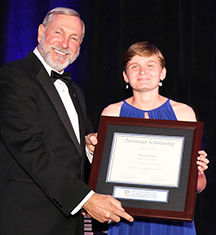
Harvey Mudd College physics major Nina Brown ’19 was named an Astronaut Scholar for the 2018–2019 academic year by the Astronaut Scholarship Foundation (ASF). She is the 25th Harvey Mudd student to receive the honor.
In August, Brown attended the ASF Innovators Gala in Washington D.C., where she received her award and spent time getting to know other foundation members.
“The gala was a lot of fun,” she says. “I sat next to two men who run a company working on clean hydrogen energy; they had a lot of great advice for working in science. Additionally, one of the keynote speakers was astronaut Dave Scott. He told the story of the Gemini VIII mission, flown by Neil Armstrong and himself. The spacecraft’s steering wasn’t working properly, and they had to return to Earth with a malfunctioning thruster. He detailed how he and Armstrong made it back, including lots of exciting and scary moments.”
While the scholarship doesn’t include opportunities for that type of space exploration, it does offer the exciting benefit of a mentoring program intended to help scholars explore their career options. “I’ve been assigned a mentor who works as a systems engineer with the federal government,” says Brown, who is interested in condensed matter and materials physics. “I’m excited to learn about that path. When I applied for the scholarship, I did not quite realize that the ASF provided so many opportunities for scholars beyond the initial scholarship. I’m excited to be a part of a network of thoughtful, successful people who care about science and improving the world around them.”
After graduation from Harvey Mudd, Brown plans to work in industry for a few years, then pursue a PhD in condensed matter physics. “I’d ultimately like to work in a field that has a clear, positive impact on people’s lives, such as developing clean energy technology or working in science outreach,” she says.
ASF scholarships provide up to $10,000 each for college students pursuing careers in science, engineering and mathematics. The scholarship rewards students who exhibit initiative, creativity and excellence in their chosen field.
Charles Dawson ’19 (physics), awarded in 2017
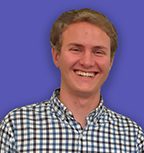
The balance between real-world applicability and long-term research goals is not always easy to achieve. But, that doesn’t deter Charles Dawson ’19, winner of the prestigious Astronaut Scholarship for the 2017–2018 academic year.
“In my career, I hope to find this balance by being mindful of the bigger picture of how to bring technological developments in the real world while pursing research at the frontiers of my field,” Dawson said. “Fundamental research has the capacity to address many of the problems facing humanity today, from energy sustainability to space exploration, but only if the scientists and engineers who conduct that research keep those problems in mind.
Dawson, an engineering major, is the 24th Harvey Mudd College student to be named an Astronaut Scholar by the Astronaut Scholarship Foundation, which provides scholarships of up to $10,000 each for college students pursuing careers in science, engineering and mathematics. The scholarship rewards students who exhibit initiative, creativity and excellence in their chosen field.
Dawson spent the summer of 2016 at Georgetown University working on computational physics research in the field of active colloidal materials, which can be used to model bacterial films and certain classes of nano-particles. Last year, he worked with physics professor Jim Eckert in the Magnetism Lab studying the electrical and magnetic properties of metallic novel materials.
“So far, I’ve worked on measuring the magnetic properties of multi-layer metallic films typically several nanometers thick that might one day be used to improve the storage capacity and speed of magnetic hard drives,” Dawson said.
His research experiences both here and at Georgetown not only taught him valuable experimental and analytical skills, but have also challenged him to ask bigger questions.
“I’ve learned that it’s not enough, for example, to find out how the magnetic properties of a material changes with its composition; you have to think about how that dependence can be used to improve the various systems built on top of that material,” Dawson said.
The creative challenge of adapting a system to new and untraditional components is something Dawson enjoys pursuing outside the research lab through various independent projects. He is building and programming control systems for an aerial robot that flies using only two motors. Limiting the number of motors presents several challenges since each motor must double as a source of thrust and a carefully controlled source of torque to control the orientation for the robot.
“One of the things I enjoy most about projects like this is that, in addition to posing fun and interesting new challenges, they allow me to dive deeply into a wide variety of topics from control to electrical engineering, and gain a deep understanding of every level of the system I’m designing,” Dawson said.
In addition to his research, Dawson chairs the College’s Honor Board and is part of the improv comedy group, “DUCK!”
“I use improv mainly to decompress, relax and have fun away from my class work,” Dawson said.
After graduation, he plans to attend graduate school to explore the intersection of physics and engineering with an eye toward applying new advances in physical understanding to engineering applications.
Calvin Leung ’17 (mathematics/physics), awarded in 2016
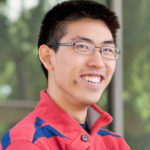
Mathematics and physics double major Calvin Leung ’17 is the 23rd Harvey Mudd College student to be named an Astronaut Scholar by the Astronaut Scholarship Foundation, which provides scholarships for college students pursuing science and technology careers.
Leung is one of 40 recipients of the prestigious $10,000 award for the 2016–2017 academic year. To be eligible for theAstronaut Scholarship, students must demonstrate innovation, creativity, exceptional performance or unusual drive in their research fields, be in high academic standing and be actively involved in research. Candidates must be at least sophomore-level students in engineering, mathematics or applied or natural sciences and must be nominated by a faculty member.
In 2014, Leung worked with Dr. Soumya Mohanty of the Laser Interferometer Gravitational-wave Observatory (LIGO) Scientific Collaboration—a team of international physics institutes and research groups dedicated to the search for gravitational waves—at the University of Texas, Brownsville, to develop an algorithm for the detection of gravitational wave signals. Since the most interesting gravitational wave events don’t have robust theoretical models to back them up, Leung says, there is interest in developing algorithms to detect arbitrary gravitational wave signals in noisy data. Using evolutionary optimization and techniques from machine learning, Leung developed a data pipeline that synthesized data from multiple gravitational wave detectors, including LIGO, in order to pinpoint the source of the signal and extract the waveform accurately even without prior knowledge of what the signal looked like.
More recently, Leung has been involved in two research projects: one devised by him and another with Assistant Professor of Physics Jason Gallicchio. Over the last four semesters, Leung developed a fast and effective way to quantify the resolution of a camera—research he’s excited to incorporate into Physics 134 (Optics Lab) curriculum and to submit to the American Journal of Physics. With Gallicchio, Leung has been building an experiment combining cosmological observation with quantum optics, examining light from distant quasars billions of light years away to determine whether quantum mechanics offers a correct description of the universe.
Like most Mudders, Leung is about more than his research, wearing many hats on campus.
“When I’m not in the lab, I get paid to geek out as an Academic Excellence physics tutor,” Leung says. In addition, he has been involved with the Honor Board since arriving as a first year, and he was the Judiciary Board chair in 2015–2016.
He says he also enjoys “rocking out on the cello, singing in the shower and unicycling silently past unsuspecting tour groups.”
After graduation, he plans to obtain his PhD in physics and join the effort to bring gravitational wave astronomy to fruition.
“Gravitational wave astronomy will be an entirely new way to do astronomy and learn about the universe,” says Leung. “Having worked on LIGO and at SpaceX, I’ve learned that I’m drawn to big, bold projects, and building the first generation of space-based gravitational wave detectors will be awesome—and will incorporate the work I’ve done in the past.”
For now, he’s thankful to those who’ve helped him along the way—particularly his family.
“I’ve enjoyed many forms of privilege throughout my life, notably that of being surrounded by a supportive family,” says Leung. “I’d like to thank my parents and my sister Lauren for their unending support, and to abolish the notion that this honor belongs to any particular individual.”
Sherman Lam ’16 (engineering), awarded in 2014 and 2015
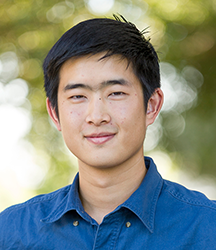
Senior engineering major Sherman Lam has become just the eighth Harvey Mudd College student to be awarded a second-year Astronaut Scholarship by the Astronaut Scholarship Foundation, which provides scholarships for college students pursuing science and technology careers.
Students who earn the prestigious $10,000 award in their junior year are eligible to apply for a second year. Lamreceived the awardduring the 2014–2015 academic year for demonstrating exceptional academic performance and dedication in robotics research in the Lab for Autonomous and Intelligent Robotics (LAIR), under the advisement of engineering Professor Christopher Clark. He receives it again in 2015–2016 for his continued research.
“Over the last year, Sherman has shown a high level of dedication to his research,” says Clark. “He has improved upon work from his 2014–2015 project in autonomous underwater glider planning by having the path planner account for ocean currents, as well as readying the planner for actual glider deployments along the East Coast to take place during fall 2015.”
Begun in spring 2015, Lam’s current project is a tensegrity-based spherical rolling robot. Together with Clark, Lam sought to create a more robust robot forlava tube exploration. Their idea is an elastic, spherical robot that can be dropped into a lava tube, land safely and navigate the space, regardless of landing orientation. The “tensegrity” is an elastic structure that allows the robot to absorb the impact of a fall, while its spherical shape allows the robot to roll around by shifting its center of mass.
“We ended up building a couple of proof-of-concept platforms that successfully demonstrated this means of locomotion,” says Lam. “We’re now working on developing a better platform that will use an inertial measurement unit to determine the robot’s orientation and have an onboard controller to drive the robot in a steady and predictable manner.”
This summer, Lam interned at NASA’s Jet Propulsion Laboratory with the Extreme Environment Robotics Group, where he created a miniaturized and highly mobile wall-climbing robot for surveillance and exploration applications. µDROP, “Micro DurableReconnaissance and Observation Platform,” is equipped with many small hooks (“microspines”) embedded in flexible wheel structures.These microspines can adhere to rough surfaces, allowing the platform to climb rough, vertical walls. Miniaturization included designing a new, small-scale printed circuit board for the onboard microcontroller and sensors, testing new microspine designs and prototyping a highly flexible chassis.
Asked whether he will attend graduate school or enter industry upon graduation, Lam is undecided. “I’m exploring my options,” he says. “My long-term career goal is to develop novel robotic platforms for space exploration. JPL is a great place for me to pursue this goal, and I would love to return to JPL in the future, either as an intern or full-time employee.”
Joshua Edelman ’14 (engineering), awarded in 2013
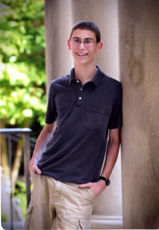
He was the first to step outside a spacecraft without the safety of a tether. He helped space-test NASA’s Lunar Module along with the life-support backpacks and rendezvous methods later used by the Apollo 11 crew that landed on the moon.
He played a leading role in saving the first Skylab mission after the craft’s thermal shield ripped off during launch. And, now, Apollo 9 astronaut Rusty Schweickart is coming to Harvey Mudd College to share his mission stories and honor a fellow space enthusiast.
On Wednesday, Oct. 2, during a public ceremony, Schweickart will present Harvey Mudd senior Joshua Edelman with a $10,000 scholarship from the Astronaut Scholarship Foundation. His talk is free and open to the public.
“Joshua has demonstrated exceptional achievement, talent and drive,” said Schweickart. “I am proud to be recognizing him on behalf of the Astronaut Scholarship Foundation in the company of his mentors, peers and the greater Harvey Mudd community.”
A De Pietro Engineering Fellow, Edelman participated in the NASA University Student Launch Initiative last year, helping to design, build and launch an 80.4-inch-long reusable rocket. He received the 2012-2013 J.R. Phillips Engineering Award for his work on a supersonic rocket drag analysis project. In 2009, Edelman interned at NASA Marshall Space Flight Center on the Aerodynamics Team performing wind tunnel tests on the Ares V.
His plans include pursuing graduate studies and an aerospace career. “I love designing, building and flying all sorts of high-power rockets,” said Edelman. “One way or another, I’m going to try to become an astronaut.”
Schweickart’s talk will focus asteroids—as rich cosmic ore bodies, stepping stones to Mars and Rosetta Stones to human life. He will discuss the threat of asteroid impacts and what might be done to address this cosmic natural hazard.Harvey Mudd is one of 27 institutions—and the only non-doctorate granting school— selected by the Astronaut Scholarship Foundation to participate in its program. To date, the foundation has awarded more than $3 million to students nationwide; $210,000 of those funds has been awarded to HMC students.
The scholarship presentation and lecture will begin at 4:15 p.m. in the Shanahan Center Auditorium at Harvey Mudd College.
Katerina Hilleke ’13 (chemistry), awarded in 2012
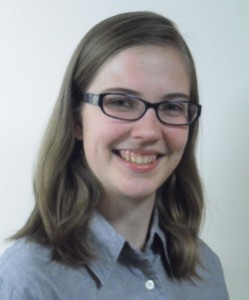
Harvey Mudd College chemistry major Katerina Hilleke ’13 has been selected as a 2012-13 Astronaut Scholar by the Astronaut Scholarship Foundation (ASF), which provides scholarships for college students pursuing science and technology careers.
She is one of 22 students nationwide this year to receive the $10,000 award, given to rising juniors or seniors who have demonstrated initiative, creativity and excellence in their chosen field.
Hilleke spent the past 18 months exploring ways to synthesize beilschmiedic acid C, a natural antibacterial product found in the bark of the Beilschmiedia anacardioides tree species in Cameroon. Discovered in 2009, the compound proved a more potent antibiotic than ampicillin.
“Beilschmiedic acid C has a complex structure and has not yet been made by chemists. Katie hopes to be the first to make this compound and to enable us to make related structures that might have enhanced antibacterial properties,” said Associate Professor of Chemistry David Vosburg. “She has devoted herself to this project intellectually, proposing and attempting a variety of new approaches to make her target molecule. She also has demonstrated independence, motivation and an ability to mentor other student researchers.”
Hilleke’s contributions to the HMC community include serving as an Academic Excellence chemistry facilitator and as a tutor for students in the Group Theory, Quantum Chemistry and Spectroscopy course. She’s also a member of the Claremont Colleges Ballroom Dance Company and the Aztec dance group Danzantes Del Sol.
Her future plans include graduate school, performing catalysis research and, possibly, becoming a teacher.
Paul Riggins ’12 (physics), awarded in 2011

HMC physics major Paul Riggins ’12 of Whittier, Calif. has been selected as a 2011-12 Astronaut Scholar by the Astronaut Scholarship Foundation (ASF), a non-profit organization providing scholarships for college students pursuing science and technology careers.
As an Astronaut Scholar, Riggins will receive a $10,000 award. Astronaut Scholars are selected based on academic performance, merit and capability in academic research and must attend one of the 19 institutions ASF supports, be entering their junior or senior year or pursuing a master’s degree and be nominated by a professor.
Riggins, who is interested in pursuing teaching and research, has been on the dean’s list for the last three years. In Spring 2010, he was awarded the Rojansky Prize by the HMC Physics Department for his term paper on quantum mechanics. He is an experienced tutor, as part of the Physics Academic Excellence team and as a physics workshop tutor preparing first-years for their upcoming mechanics course. Riggins has a strong interest in music and theater and has been active in both since high school. Most recently he was a part of the 5-C a cappella group Mood Swing and the Joint Music Program’s Chamber and Concert Choirs. He performed in a theatrical production last summer performed by La Habra High School alumni.
Riggins and classmate Dhruv Ranganathan ’12 conducted a research project on the algebraic geometry relevant to string theory with advisor and mathematics Professor Dagan Karp and HMC Mathematics Department teaching and research postdoctoral fellow Ursula Whitcher. Riggins and Ranganathan have presented their research at various seminars and meetings, including at the Western Algebraic Geometry Seminar at the University of Arizona; the Algebra, Number Theory, and Combinatorics Seminar hosted by the Claremont Center for the Mathematical Sciences; and Joint Math Meetings in New Orleans. The research team is currently writing a paper to be submitted for publication. Riggins continues to study string theory in his summer research project, currently underway with advisor and physics Professor Vatche Sahakian, which will explore more accurate models for black holes.
Andrey Shur ’11 (biology/chemistry), awarded in 2010

Senior Andrey Sergeivich Shur is among 20 recipients nationwide of the 2010-2011 Astronaut Scholarship, the country’s largest monetary award based solely on merit for science, math and engineering undergraduates and postgraduate students. This year’s scholarships totaled $200,000.
Shur, a Los Angeles native, is pursuing a joint chemistry and biology major with plans for a career in biochemistry research. His other interests include robotics, mechanical engineering and drawing. ” I plan on pursuing a career as a researcher at a biotech/ pharmaceutical company,” said Shur. “I feel that the future is in biology.”
The awards are granted by the Astronaut Scholarship Foundation, a nonprofit organization founded in 1984 by the six surviving original Mercury astronauts. The foundation supports the nation’s global leadership in science and technology by providing scholarships for college students who exhibit motivation, imagination, and exceptional performance in these fields.
Bryan Teague ’10 (engineering), awarded in 2009
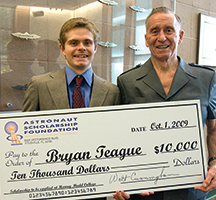
Apollo Astronaut Walt Cunningham presented Harvey Mudd College (HMC) senior Bryan Teague with a $10,000 scholarship from the Astronaut Scholarship Foundation (ASF) during a public presentation and ceremony Oct. 1 in Galileo McAlister on the HMC campus.
The Astronaut Scholarship is the largest monetary award based solely on merit that is given in the United States to science and engineering undergraduate students. Eighteen of these prestigious awards were dispersed this year through the ASF to outstanding college students majoring in science, engineering or math. Over $2.8 million has been awarded in scholarships to date, $190,500 to HMC students. These well-rounded students exhibit motivation, imagination and intellectual daring, as well as exceptional performance, both in and outside, the classroom.
“Students, like Bryan, are the pioneers of our future,” said Cunningham, “He will forever be included in the Astronaut Scholarship Foundation’s elite group of Astronaut Scholars. Our scholars have gone on to work with the Hubble telescope discovering the furthest galaxy documented to date, helped design several of the world’s most prestigious fighter jets, have been named some of the top 50 technical leaders by Scientific America and much more.”
Teague, son of Terrance and Leslie Teague of Boulder, Colo., will graduate in May 2010 with a degree in general engineering. He is interested in electric cars and worked with a team at the University of West Australia, where he studied for a semester, to try to convert a Lotus Elise to a fully electric vehicle. Teague is equally involved with materials science, specifically energy and power generation and has worked on developing photo initiated thiolene polymers. He is also a candidate for senior class president. In his spare time, Teague enjoys biking and backpacking.
“Bryan is an excellent choice for this award, and we’re proud that he is continuing HMC’s winning tradition,” said President Maria Klawe. Seventeen HMC students have received a total of $190,500 in scholarships since 1987. “We are thrilled that the Astronaut Foundation shares our enthusiasm for well-rounded students who exhibit exceptional performance in science and engineering.”
After the presentation, Cunningham spoke to the audience about fear, risk taking and leadership. He asked, “Are we doomed, all of us, to a future with a fixation on safety and security? Must our resources be used only for feeding our existence, never for dreaming and reaching? If you’re not willing to risk failing, then you don’t deserve to win. But when you win, you win big.”
Cunningham was selected by NASA as an astronaut in October 1963. On October 11, 1968, Cunningham, Wally Schirra and Donn Eisele were launched aboard Apollo 7 – the first manned flight of the Apollo Program following the tragic Apollo 1 fire. The 260-hour, 4.5 million-mile flight was a success and provided NASA with confidence to send the next Apollo crew, Apollo 8, into orbit around the moon.
“Against enormous odds, with the whole world watching, a group of engineers, scientists and managers accepted the challenge, took a risk and changed the way that we perceived our world,” he said. “Was space the last frontier? No, it wasn’t. It was just the latest of the last frontiers. Those frontiers are always there—in science, medicine and even business. You think Bill Gates didn’t blaze a new frontier? The trick is locating those frontiers, and that takes vision, imagination. It takes individuals willing to search for excellence and the boundaries of our knowledge. It takes individuals willing to accept a challenge and who are prepared to pay the price—not cautious naysayers.”
Cunningham retired from NASA in 1975 and was inducted into the U.S. Astronaut Hall of Fame in 1997. He currently serves on the ASF Board of Directors.
Nadia Abuelezam ’09 (biology/mathematics), awarded in 2008
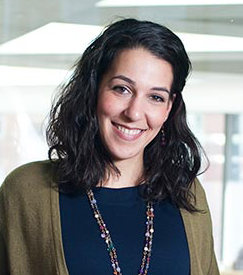
The Astronaut Scholarship Foundation (ASF) has named Nadia Abuelezam ’09 an Astronaut Scholar, a prestigious honor bestowed on only 19 college students each year.
Candidates, nominated by faculty members from a handful of designated colleges and universities, receive a $10,000 scholarship for their continuing education.
“The group of schools supported by the Astronaut Scholarship is a truly elite group, and Harvey Mudd’s inclusion is a true honor,” said Robert Cave, vice president for academic affairs and dean of faculty. “Nadia Abuelezam is a perfect example of both what HMC and the Astronaut Foundation hope to achieve in and through young people. She is extremely bright, intellectually adventuresome and committed to important issues the world is facing.”
“I am super excited about winning this award,” added Abuelezam, who is majoring in mathematical biology, with an emphasis on mathematical modeling of infectious diseases. “It means a great deal to be named an Astronaut Scholar and I look forward to living up to all expectations.”
This summer, Abuelezam, who is from San Mateo, Calif., will be working with The AIDS Support Organization in Uganda, Africa. She will be trying to improve the efficiency of the organization’s HIV/AIDS clinics and centers by optimizing their anti-retroviral drug distribution.
“I hope that my mathematical work will help the organization reach out to more HIV/AIDS infected people,” said Abuelezam, who plans to pursue a doctoral degree in epidemiology after HMC and conduct field work with major international health organizations such as UNAIDS and the World Health Organization. “I look forward to applying what I know there and seeing the difference I can make with my education.”
While in Uganda, Abuelezam will also be working with high school and middle school students. “I am bringing along letters from fellow Mudders encouraging these Ugandan students to continue their education,” she said.
As an Astronaut Scholar, Abuelezam joins the company of recent HMC graduates Samuel Eisenberg ’08 and Robert Panish ’06.
Samuel Eisenberg ’08 (physics), awarded in 2006 and 2007
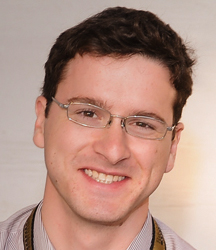
Eisenberg, a physics graduate and co-founder of the environmental group Mudders Organizing for Sustainability Solutions, was named an Astronaut Scholar both in 2006 and 2007 for his outstanding work in the field of magnetic materials.
In 2007, during a public presentation and ceremony, Space Shuttle astronaut Gordon Fullerton presented Eisenberg with his award.
Panish, an engineering graduate with an interest in space vehicle design, received the Astronaut Scholarship in 2005.
As a scholarship recipient, he was invited to the Kennedy Space Center in Florida, where he attended the annual Astronaut Hall of Fame Induction Ceremony, met with astronauts, attended VIP tours of the space center and walked under the Space Shuttle Endeavor.
He was also featured on the cover of ASF’s May 2006 magazine, which focused on his research with Engineering Professor Zee Durón ’81 creating an early warning system for firefighters that will predict structure collapse.
Since receiving the Astronaut Scholarship, Panish has remained actively involved with the ASF, attending the organization’s annual meetings and speaking at a 2006 gathering commemorating the 40th anniversary of the Gemini 12 flight.
“Any scholar who chooses to go to the annual meeting develops lifelong friendships with the other scholars as well as meaningful relationships with dozens of former astronauts, including men who walked on the moon,” he said.
The ASF, established in 1984 by the six surviving members of America’s original Mercury Seven astronauts, was created to ensure that the United States would maintain its leadership in science and technology in the future by supporting promising college students who exhibit motivation, imagination and exceptional performance in the science or engineering field of their majors.
While scholarship recipients must display intellectual prowess, the committee also looks for well-rounded students who are involved in campus and community activities.
To date, the foundation has awarded nearly $2.5 million in scholarships to 226 deserving students, according to the organization’s website.
Robert Panish ’06 (engineering), awarded in 2005
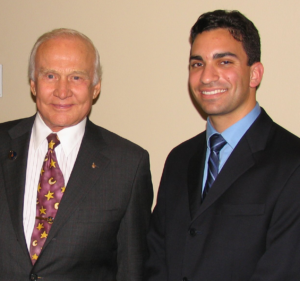
Robert Panish ’06, an engineering graduate with an interest in space vehicle design, received the Astronaut Scholarship in 2005.
As a scholarship recipient, he was invited to the Kennedy Space Center in Florida, where he attended the annual Astronaut Hall of Fame Induction Ceremony, met with astronauts, attended VIP tours of the space center and walked under the Space Shuttle Endeavor.
He was also featured on the cover of ASF’s May 2006 magazine, which focused on his research with Engineering Professor Zee Durón ’81 creating an early warning system for firefighters that will predict structure collapse.
Since receiving the Astronaut Scholarship, Panish has remained actively involved with the ASF, attending the organization’s annual meetings and speaking at a 2006 gathering commemorating the 40th anniversary of the Gemini 12 flight.
“Any scholar who chooses to go to the annual meeting develops lifelong friendships with the other scholars as well as meaningful relationships with dozens of former astronauts, including men who walked on the moon,” he said.
Previous Recipients
Adam Pivonka ’05 (physics), awarded in 2004
William Kolthammer ’04 (physics), awarded in 2003
David Diaz ’03 (engineering), awarded in 2001 and 2002
Nicholas Bodnaruk ’01 (engineering), awarded in 2000
Robert Walters ‘01 (physics), awarded in 2000
Belinda Fischer ’00 (independent program of studies), awarded in 1999
Whittier Myers ’99 (physics), awarded in 1997 and 1998
Carl Coryell-Martin ’97 (physics), awarded in 1995 and 1996
Paul Parker ’95 (physics), awarded in 1993 and 1994
Deborah Swarts ’93 (physics), awarded in 1991 and 1992
Jennifer Galvin ’91 (chemistry), awarded in 1990
Doug Dunston ’90 (physics), awarded in 1989
Ken Easton ’89 (engineering), awarded in 1987 and 1988